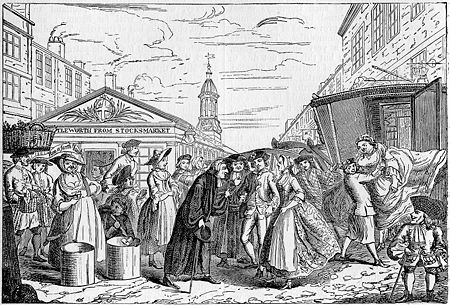

Before the Hardwick Marriage Act of 1753, it was much simpler to get married in England. All you needed was a compliant clergyman. Many of these irregular or clandestine marriages were conducted in or near the Fleet prison, to which debtors were consigned, because it was not actually part of any parish in London. Clergymen who had no living of their own, and thus no regular income, could be found in that vicinity for couples who wished speed or secrecy.
 The 1753 Marriage Act protected heiresses, who could no longer be carried off and married by scoundrels who wanted their money. It was not any protection for the poor, since it simply made marriage more expensive.
The 1753 Marriage Act protected heiresses, who could no longer be carried off and married by scoundrels who wanted their money. It was not any protection for the poor, since it simply made marriage more expensive.
In 1833, John Southerden Burns published a study of the Fleet registers, in which many decades of irregular marriages had been recorded. He listed a number of reasons why people chose a Fleet marriage, including this one:
“When a woman desired to get rid of her debts by marriage, yet shrank from putting herself into the power of some low ruffian. In the case of one Deborah Nolan the bridegroom was a woman dressed as a man, and calling himself John Ferren, Gentleman. Of course the creditors might look for John Ferren, Gentleman, as long as they pleased.”
There is definitely a novel in that little entry.

Comments
A Hidden Tale Waiting to Be Told
What a fascinating glimpse into social history! The story of Deborah Nolan and “John Ferren, Gentleman” is such a perfect seed for a historical novel — full of intrigue, gender disguise, and the clever ways people navigated the law. Thanks for sharing this gem
Post new comment